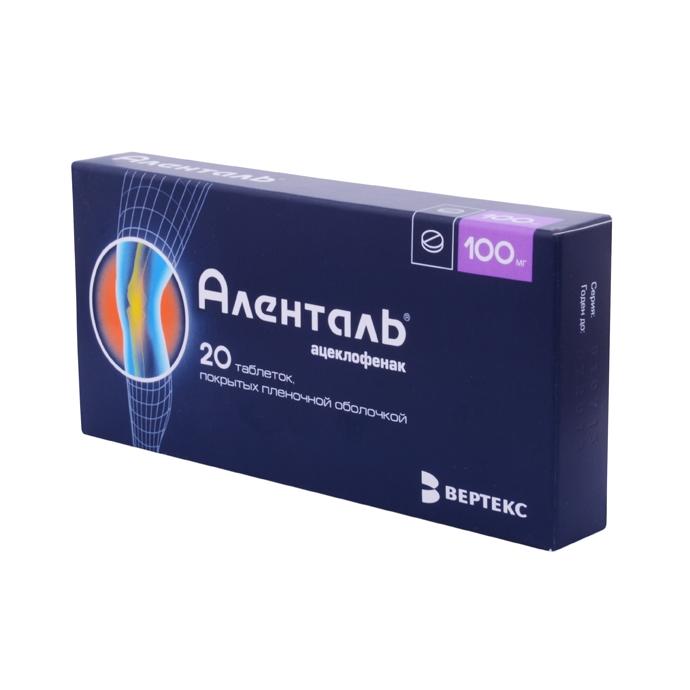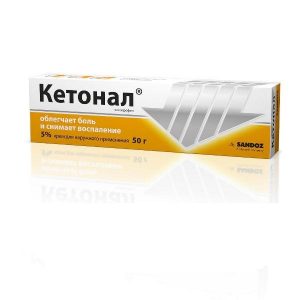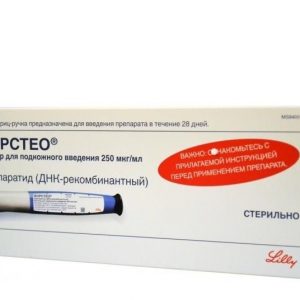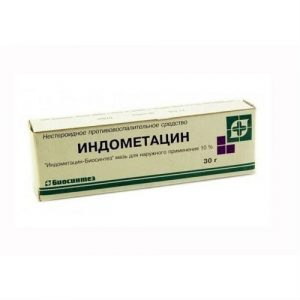Description
Release form
Tablets.
Packing
20 pcs.
Pharmacological action
Pharmacological action – anti-inflammatory, antipyretic, analgesic.
Pharmacodynamics
Aceclofenac has anti-inflammatory, analgesic and antipyretic effects. Inhibits the synthesis of GHGs and thus affects the pathogenesis of inflammation, the occurrence of pain and fever. In rheumatic diseases, the anti-inflammatory and analgesic effect of aceclofenac significantly reduces the severity of pain, morning stiffness, swelling of the joints, which improves the patient’s functional state.
Pharmacokinetics
Absorption. After oral administration, aceclofenac is rapidly absorbed, its bioavailability is close to 100%. Tmax in blood plasma is 1.25–3 hours after oral administration. Eating slows down absorption, but does not affect its degree.
distribution. Aceclofenac is highly bound to plasma proteins (> 99.7%). Aceclofenac penetrates into the synovial fluid, where its concentration reaches 60% of its concentration in blood plasma. Vd is 30 liters.
Metabolism. Believed that aceclofenac is metabolized by the CYP2C9 isoenzyme to form a 4-OH-aceclofenac metabolite, whose contribution to the clinical effect of the drug is likely to be minimal. Diclofenac and 4-OH-aceclofenac are among the numerous metabolites of aceclofenac.
Withdrawal. The average T1 / 2 is 4–4.3 hours. The clearance is 5 l / h. Approximately 2/3 of the dose taken is excreted by the kidneys, mainly in the form of conjugated hydroxymetabolites. Only 1% of the dose after oral administration is excreted unchanged.
Indications
relief of pain and pain , humeroscapular periarthritis, rheumatic soft tissue lesion
symptomatic treatment of rheumatoid arthritis, osteoarthritis, ankylosing spondylitis.
The drug is intended for symptomatic therapy, reducing pain and inflammation at the time of use, does not affect the progression of the disease.
Contraindications
– hypocalcemia
– inability of the patient to stand or sit straight for at least 30 min
– severe renal failure (CC less than 35 ml / min)
– severe disturbances in the mineral metabolism
– stricture or achalasia obstructive
– food advancing along the esophagus
– severe hypoparathyroidism
– calcium malabsorption
– lactose intolerance
– lactase deficiency
– glucose-galactose malabsorption
– pregnancy srlkrd – srlk pregnancy – srdl period
With caution, gastrointestinal tract diseases in the acute phase (dysphagia, esophagitis, gastritis, duodenitis, gastric and duodenal ulcer), vitamin D deficiency.
Special instructions
It is necessary to control the possibility of any signs of adverse reactions from the esophagus. The patient should be informed about the need to stop taking the drug Alental and see a doctor if dysphagia develops, pain when swallowing, pain behind the sternum or heartburn.
Inform patient that there is a risk. damage to the mucous membrane of the esophagus if the instructions for use are not followed.
In the presence of hypocalcemia, it is necessary to correct it before starting treatment. Therapy should be combined with a diet enriched with calcium salts and vitamin D.
During treatment, a slight asymptomatic decrease in the concentration of calcium in blood serum and phosphates is possible due to the positive effect of alendronic acid on bone mineral density, which is of particular importance for patients receiving corticosteroids because they may have reduced absorption of calcium.
Pathological (i.e., minor and spontaneous) subtrochanteric fractures or fractures of the proximal femoral dyaphysis were reported in a small number of patients taking bisphosphonates. Some of the fractures belonged to the category of stressful (also known as stress fracture, mid-flight, fracture, or Deutschland fracture) arising in the absence of injury.
Some patients, weeks or months before a complete fracture, experienced prodromal pain in the affected area, often associated with a characteristic radiological picture of a stress fracture. The number of messages was very small, in addition, stress fractures with similar clinical features also occur in patients not taking bisphosphonates.
Patients with stress fractures should be evaluated to assess known causes and risk factors (e.g., vitamin D deficiency, malabsorption, GCS history, stress fracture, arthritis or fracture of the lower extremities, excessive or increased stress, diabetes mellitus, chronic alcoholism) and provide them with appropriate orthopedic care. Before obtaining the results of the examination, consideration should be given to suspending the administration of bisphosphonates in patients with stress fractures, based on an assessment of the benefit / risk ratio in each case.
Influence on the ability to drive vehicles and control mechanisms
Not affected.
Composition
film-coated tablets 1 tab.
active substance:
aceclofenac 100 mg
excipients:
MCC – 82.6 mg
croscarmellose sodium – 8 mg
povidone K30 – 6.4 mg
sodium stearyl fumarate – 3 mg
film sheath:
hypromellose – 3.6 mg
talc – 1.2 mg
titanium dioxide – 0.66 mg
macrogol 4000 (polyethylene glycol 4000) – 0.54 mg
or dry mix for film coating (hypromellose – 60%, talc – 20 %, titanium dioxide – 11%, macrogol 4000 (polyethylene glycol 4000) – 9%) – 6 mg
Dosage and Administration
Inside.
For osteoporosis in postmenopausal women and men, 70 mg once a week or 10 mg 1 time / day, without chewing, 2 hours (but not less than 30 minutes) before the first meal, water or other medicines funds. Drink only with plain water,
since other drinks (including mineral water, coffee, tea, orange juice) reduce absorption. Do not chew or dissolve tablets.
For Paget’s disease – 40 mg / day. within 6 months
Dose adjustment in elderly patients is not required.
To reduce the irritating effect on the esophagus, the drug Alental must be taken immediately after the morning rise, washed down with a full glass of water, after administration it should not go to bed for 30 minutes (it is dangerous to use if the patient is unable to stand or sit straight for 30 minutes).
Taking at bedtime or in a horizontal position increases the risk of developing esophagitis.
If you accidentally skip a dose once a week, take 1 tablet in the morning of the next day. Pills should not be taken on the same day, but in the future it is necessary to continue to take 1 tablet on that day of the week, which was chosen to be taken from the very beginning of treatment.
Dose adjustment in patients with mild to moderate renal failure (CC from 35 to 60 ml / min) is not required.
Side effects
From the digestive system: dysphagia, esophagitis, abdominal pain, heartburn, dyspepsia, constipation, diarrhea, flatulence. Rarely, nausea, vomiting, gastritis, melena, esophageal stricture, ulcers of the oral mucosa and pharynx, esophageal ulcer, perforation of the esophageal ulcer with bleeding.
From the musculoskeletal system: pain in the bones, muscles and joints.
From the side of the central nervous system: headache
From the side of the organ of vision: uveitis, scleritis.
Allergic reactions: rarely – urticaria, angioedema has been reported on isolated cases of Stevens-Johnson and Lyell syndromes.
Others: rash, pruritus, erythema, photodermatosis, symptomatic hypocalcemia, cases of development of osteonecrosis of the upper and lower jaw are described, mainly in patients with oncological diseases in the background, antitumor treatment, including bisphosphonates. Risk factors for developing osteonecrosis are cancer, chemotherapy, radiation therapy, treatment of corticosteroids, inadequate oral hygiene, local infectious and inflammatory processes, including osteomyelitis. In the majority of cases described, patients were treated with bisphosphonates during tooth extraction.
Laboratory data: slight and transient decrease in calcium and phosphate concentrations.
Typical symptoms at the start of treatment: myalgia, malaise, and rarely fever.
Drug Interactions
The interval between taking Alental and other drugs and food additives should be at least 1 hour.
The combined use of alendronic acid (but not simultaneous administration) with HRT preparations (estrogen + aprogestin) is not accompanied by a change in the safety profile and tolerability of each drug compared to their separate use.
The use of alendronic acid and drugs for HRT (estrogen + progestin) leads to a greater increase in bone mass compared to taking each of the drugs separately.
The simultaneous use of calcium and antacid preparations reduces the absorption of alendronic acid.
Ranitidine increases bioavailability by 2 times (clinical value not determined). In clinical studies, an increase in the frequency of side effects from the upper gastrointestinal tract in patients taking more than 10 mg of alendronate per day along with drugs was noted, containing acetylsalicylic acid.
Sodium alendronate may be prescribed to patients taking NSAIDs. In a 3-year controlled clinical trial (number of patients 2027), during which most patients took NSAIDs as concomitant therapy, the number of adverse events related to the upper gastrointestinal tract was similar in patients receiving sodium alendronate at a dose of 5 and 10 mg / day, and in patients receiving placebo. However, the use of NSAIDs is associated with irritation of the gastrointestinal mucosa, so the use of NSAIDs together with alendronic acid should be careful.
Active ingredient
Aceclofenac
dosage form
tablets
Vertex, Russia




